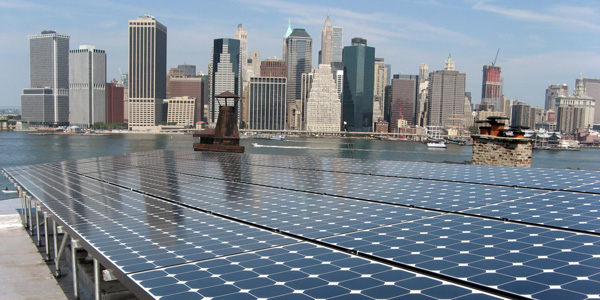COOPERSTOWN, N.Y. — As it wrestles with the increasing penetration of distributed energy resources and growing efforts to decarbonize the grid, FERC is closely watching New York’s efforts to price carbon into its wholesale electricity market.
“New York is working on carbon pricing, which is an attempt to reflect and achieve and reconcile state policy goals in the market, through the market, rather than just accommodate them as in New England and PJM,” Becky Robinson, deputy director of FERC’s Division of Economic and Technical Analysis, told NYISO’s Management Committee on Tuesday. “So the commission is watching very closely.” (See NYISO Favors Cost Levelizing on Carbon Charge.)
Staff from FERC’s Office of Energy Policy and Innovation also attended the meeting June 12 and answered questions from stakeholders.
ISO-NE’s Competitive Auctions with Sponsored Policy Resources construct “is what we term more of an accommodate approach, where the goals are to allow state-supported resources to participate in the capacity market, but put a structure in place that maintains competitive markets,” Robinson said. (See Split FERC Approves ISO-NE CASPR Plan.)
PJM has also filed two competing proposals dealing with state-sponsored resources that the commission must rule on by June 29, she said.
“The first PJM proposal, capacity repricing, is a different type of accommodate solution, and the second is what they call MOPR-Ex, which expands” PJM’s existing minimum offer price rule to bar subsidized resources from receiving a capacity commitment, Robinson explained. (See PJM Urges FERC to Act on ‘Jump Ball’ Despite Criticism.)
DERs Feedback
Speaking about the commission’s April 10-11 technical conference on distributed energy resources, Robinson said “one key takeaway is that states want flexibility. You still need to flesh out what is the role of the distributing utility relative to that of the aggregator.” (See Ready to Act on DERs, FERC Tells Congress.)
Asked about the key areas the commission is examining in market rules for DERs, Robinson said, “Coordination is a big one … and double-counting is an issue. We think there are ways — there are tools you can use — to avoid that. And jurisdiction, that has been contentious in the docket: Who does what and where?”
Couch White attorney Kevin Lang, representing New York City, said opinions differ on how to look at FERC Order 841. (See FERC Rules to Boost Storage Role in Markets.)
“Some people think it means we should be creating rules to recognize the differences in those technologies from more traditional types of generation resources, and other folks have assumed that we should be trying to create the same rules as much as possible between new technologies and traditional resources,” Lang said.
He asked whether an energy storage project should have to meet the same market rules as a 500-MW combined cycle unit.
“I think we tried to indicate some flexibility on that,” Robinson said. “Commission staff look for ways to rationalize the participation model. … On the DER space, I don’t think we proposed a participation model for DER aggregation.”
Adequate Summer Capacity Forecast
NYISO Vice President of Operations Wes Yeomans told the committee the ISO is prepared to meet peak demand this summer, with a total of 42,169 MW of resources available to cover an expected peak of 32,904 MW, which is 2.9% above the long-term average.
Yeomans said his report was identical to that presented to the Operations Committee and the press on May 30, except for a note explaining that that the Market Monitoring Analysis Group (MMA) had visited 22 generator sites to check their reliability readiness. (See NYISO Ready to Meet Summer Demand.)
The MMA reviewed planned maintenance outages and practices in order to reduce forced outages, and also checked that generators had adequate supplies of backup fuel storage.
2018 Master Plan Focuses on Grid Evolution
NYISO is this year preparing a Master Plan with three key themes: resource flexibility, grid resilience and price formation.
Michael DeSocio, the ISO’s senior manager for market design, told the committee that ISO staff are working on a comprehensive five-year plan to prepare for anticipated changes to the bulk power system, with a focus on projects that help prepare for the evolution of the grid.
“The addition of renewable resources expected as a result of the [state’s] Clean Energy Standard will create a more dynamic grid, where supply is heavily influenced by the weather,” the draft plan said. “This necessitates a look at the incentives for flexible resources that will be needed to balance intermittent renewables, as well as alternative market designs that preserve revenue adequacy for generators needed for reliability.”

NYISO is examining how to incentivize development of flexible resources needed to balance the growth of intermittent renewables on its grid. | DOE
“Some grid operators are concerned about fuel security, but we feel pretty comfortable about fuel energy security,” DeSocio said.
Nonetheless, future changes to New York’s fuel supply mix, as well as increased demands for natural gas, may stress the grid, and the ISO recommends that it conduct a 10-year fuel security study in 2019 and, if necessary, implement market design changes in 2021.
“On carbon pricing, we got a lot of feedback,” DeSocio said, noting that stakeholders have commented that the ISO should accelerate the proposed timeline for implementing carbon pricing.
The ISO is also thinking about how to implement the market design, which they expect to have complete by Q2 2019, DeSocio said.
The revised Master Plan timeline accommodates carbon pricing implementation in 2021, which could be advanced to 2020 if stakeholders want to make it their top priority, he said.
Mark Younger of Hudson Energy Economics said he supported pricing carbon as quickly as possible, but shared the Market Monitoring Unit’s concerns about why so many of the other initiatives in the plan are listed as taking four years.
For example, transmission clearance prices: “It’s unclear why that should be hard to implement,” Younger said.
The deadline for stakeholders to submit replies to a Master Plan project prioritization survey is June 26.
— Michael Kuser


